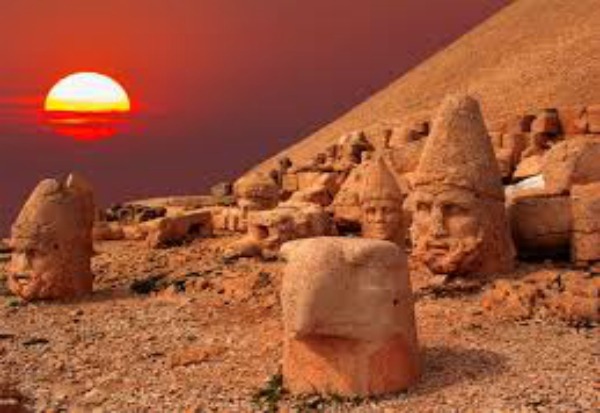Nemrut Dagi[1]
Per i 37 scrittori bruciati vivi in un incendio appiccato da integralist islamici durante un convegno il 3 luglio 1993, a Sivas, in Turchia
Volpe argentea
Che carpisci i raggi della luna,
Ladroneggiando per le colline dell’Asia Minore
Sopra di te, il monte Nemrut Dagi,
Tombe di re e satrapi Commageni
Sferzate dal vento
Morse dal tempo
Teste di dei
Crollate
Ai piedi
Di torsi troneggianti
Fissano con occhi di pietra
Gli atti indecifrabili
Dei viventi
Giù
Nella valle.
Nella fessura della bocca di un dio
Un ranuncolo si nutre
Del latte amaro della storia.
Sotto l’assembramento di dei
Dentro una casupola di lamiera,
Uomini scuri fanno bollire il chai
Sotto l’ombra del Re
Le donne curde stanno sveglie
Per infornare le pagnotte dell’ospitalità.
Volpe argentea
Complice del Sole
Che lo assisti e favoreggi
Nel rito quotidiano della dislocazione
Corri a Sivas, giù nella valle, a rubare il cuore oscuro
Di chi punisce con il fuoco
Lasciando testimonianze di cenere
Laddove prima il paradosso della penna
Secerneva una scia argentea di possibilità
Volpe argentea
Amica segreta
Dei fantasmi dei tempi che furono
Che insegui la luna
Sui colli d’Anatolia
I corpi è possibile incenerirli
Ma la voce perdura
Nella brezza
Antenata comune di tutte le voci
Sorella della parola
Portatrice dei suoni
Che le bocche non possono più formare
Consegnale tu al mondo le loro parole
Volpe argentea
Mentre corri
A scacciare la luna
E salutare il nuovo giorno
(1993)
[1] Situata nella parte sud-orientale della Turchia, il Monte Nemrut è anche un sito archeologico di grande rilevanza famoso per le sue grandi statue che risalgono al 62 a.C. Alte nove metri facevano parte di un luogo sacro e tomba del re Commagene Antioco I. Situato in cima al monte, il complesso monumentale comprende uno schieramento di dei e re di pietra le cui teste sono crollate e rimangono sparse per terra. Il sito viene visitato all’alba o al tramonto. Volpi dal manto argenteo sono state avvistate nelle vicinanze.
Nemrut Dagi[1]
For the 37 secular writers burned alive in Sivas, Tiurkey,
on July 3, 1993 in a fire set by Muslim fundamentalists
Silver fox
Stealing the rays of the moon,
Thieving in the foothills of Asia Minor.
Above you, Nemrut Dagi
Grave of satraps and Commagene kings
Whipped by the wind,
Bitten by time.
Heads of gods
Fallen
At the feet
Of enthroned bodies,
Staring with stony eyes
At the undecipherable deeds
Of the living,
Down below,
In the valley.
In the crevice of a God’s mouth
A buttercup
Nurses the bitter milk of history.
Inside a tin shack,
Below the lineup of gods,
Dark men are boiling chai,
In the shadow of the King
Kurdish women are up
Baking the loaves of hospitality.
Silver fox,
Accomplice to the Sun,
Aiding and abetting
In the daily ritual of displacement
Won’t you run to Sivas and steal the dark heart
Of men who punish by fire
Turn the silvery trail of possibilities
Secreted by the pen
Into
A testimony of ashes
Silver fox
Secret friend to
Ghosts of times gone by,
Chasing the moon
On the plains of Anatolia…
Though the body may burn
The voice lingers on
The wind,
Grandmother of voices,
Sister to the word,
Carries the sounds
Mouths can no longer speak.
You deliver them to the world,
Silver fox
On your run
Chasing away the moon,
Greeting the new day.
(1993)
[1] Nemrut Dagi in south-eastern Turkey is a mountain and archaeological site notable for the vast statues dating to 62 BC. The 9 meter statues were part of worship site and tomb of the Commagene King Antiochus I. The monumental complex at the summit of the mountain includes a row of stone kings and gods whose heads have fallen to the ground and lay scattered about. The site is usually visited either at dawn or sunset. Silver colored foxes have been spotted in the vicinity.
